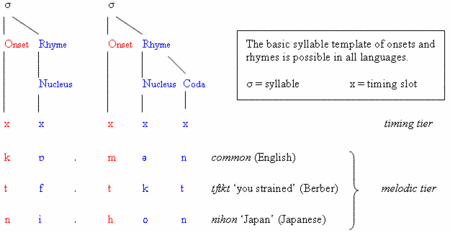Syllable: Difference between revisions
imported>John Stephenson (Added Syllable.gif with description) |
imported>John Stephenson (Evidence for the syllable) |
||
| Line 6: | Line 6: | ||
The existence of the syllable as an abstract phonological unit that limits the possible sequences of segments is not uncontroversial, and its use in mainstream linguistics literature has been inconsistent. Theories predating the arrival of the currently-mainstream ''[[generative phonology]]'', as well as more recent approaches from within [[generativism]] itself, have called into question or even outright rejected the syllable in favour of other behavioural explanations from within both phonology and [[phonetics]]. | The existence of the syllable as an abstract phonological unit that limits the possible sequences of segments is not uncontroversial, and its use in mainstream linguistics literature has been inconsistent. Theories predating the arrival of the currently-mainstream ''[[generative phonology]]'', as well as more recent approaches from within [[generativism]] itself, have called into question or even outright rejected the syllable in favour of other behavioural explanations from within both phonology and [[phonetics]]. | ||
==Evidence for the syllable== | |||
:''Main article: [[Evidence for the syllable]]'' | |||
Evidence for the existence of syllables in the world's languages can be divided into evidence both ''external'' and ''internal'' to the system of language. The former refers to ideas about syllables in various [[culture]]s, such as their use in [[poetry]], as well as speakers' 'intuitions' about them. Internal evidence refers to actual linguistic behaviour (e.g. positions where speakers modify a [[pronunciation]]), which can perhaps be better accounted for if it is assumed that 'rules' of phonology operate within the syllable rather than some other domain. | |||
There are several pieces of external evidence for the syllable: | |||
* Its place in various cultures around the world; for instance, there are many [[writing systems]], known as [[syllabary|syllabaries]], that write syllables rather than individual [[phoneme]]s (distinctive segments); | |||
*Their use in [[language games]], such as [[Pig Latin]], where syllables are moved around; | |||
*Native speaker intuitions; people often 'feel' that [[word]]s are not the fundamental unit of speech, but are further divided into smaller units; | |||
*[[Speech error]]s and [[wordplay]] seem to keep syllables intact; e.g. ''town drain'' is a possible [[spoonerism]] for ''down train'', but *''nown traid'' is not; | |||
*[[Typology (linguistics)|Typology]] (language classification according to structure): most languages seem to have syllables, and certain types are particularly common. | |||
Internal evidence involves a more complex analysis of linguistic behaviour. For example, word [[stress (linguistics)|stress]] in many languages seems dependent on the number and type of syllables, and the ordering of speech segments tends to group into syllable-like sequences of consonants and vowels, typically CV. | |||
==See also== | ==See also== | ||
Revision as of 22:41, 3 April 2007
The syllable is a unit of organisation in phonology, the system responsible for the patterns of sounds and signs in language. Typically, a syllable consists of a vowel and at least one consonant, though various combinations are possible, including single vowels. The number and type of syllables in a word, phrase or sentence may strongly influence stress and intonation throughout.
In linguistics, the existence of syllables as organisers of speech sounds and sign language movements is typically used to explain observations about what is possible in language, from native speakers’ perceptions of how many 'beats' there are in a word to the possible ordering of segments such as c, a and t in cat: why English speakers 'feel' there are two syllables in mother but only one in fire, and why *nxalr is not a possible word in English and, indeed, most languages.
The existence of the syllable as an abstract phonological unit that limits the possible sequences of segments is not uncontroversial, and its use in mainstream linguistics literature has been inconsistent. Theories predating the arrival of the currently-mainstream generative phonology, as well as more recent approaches from within generativism itself, have called into question or even outright rejected the syllable in favour of other behavioural explanations from within both phonology and phonetics.
Evidence for the syllable
- Main article: Evidence for the syllable
Evidence for the existence of syllables in the world's languages can be divided into evidence both external and internal to the system of language. The former refers to ideas about syllables in various cultures, such as their use in poetry, as well as speakers' 'intuitions' about them. Internal evidence refers to actual linguistic behaviour (e.g. positions where speakers modify a pronunciation), which can perhaps be better accounted for if it is assumed that 'rules' of phonology operate within the syllable rather than some other domain.
There are several pieces of external evidence for the syllable:
- Its place in various cultures around the world; for instance, there are many writing systems, known as syllabaries, that write syllables rather than individual phonemes (distinctive segments);
- Their use in language games, such as Pig Latin, where syllables are moved around;
- Native speaker intuitions; people often 'feel' that words are not the fundamental unit of speech, but are further divided into smaller units;
- Speech errors and wordplay seem to keep syllables intact; e.g. town drain is a possible spoonerism for down train, but *nown traid is not;
- Typology (language classification according to structure): most languages seem to have syllables, and certain types are particularly common.
Internal evidence involves a more complex analysis of linguistic behaviour. For example, word stress in many languages seems dependent on the number and type of syllables, and the ordering of speech segments tends to group into syllable-like sequences of consonants and vowels, typically CV.
